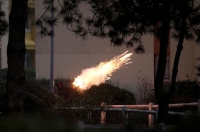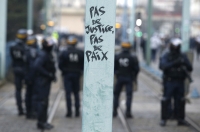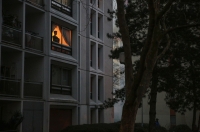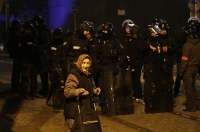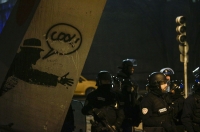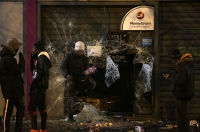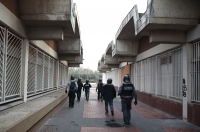The art of blending in
Paris -- When you work for a news agency, you have to be a chameleon. You can photograph a football match one day, a fashion show the next, followed up by an agriculture fair, or clashes between law enforcement officers and demonstrators protesting police brutality.
The latter requires its very own set of chameleon skills. Lately, I’ve had lots of opportunities to use them. Why? Well, you could say I’m the last in the pecking order.
I’ve been a stringer for AFP in Paris for a year. The agency has some 15 staff photographers based at headquarters, and a stringer who has been around much longer than me. So I’m the 17th on the list of importance. I'm also the youngest and I don’t have any kids. Meaning I often get assignments that take place early in the morning, late at night, and on weekends. Which is when protests tend to happen.
 Anti-riot officers in the Paris suburb of Bobigny, February 11, 2017. (AFP / Geoffroy Van Der Hasselt)
Anti-riot officers in the Paris suburb of Bobigny, February 11, 2017. (AFP / Geoffroy Van Der Hasselt)Normally when I get a call for an assignment, I know where to go. With demonstrations, it’s a bit trickier, especially when they dissolve into clashes. I have to be able to quickly orient myself and to move around easily.
That is just what happened during the recent demonstrations around Paris that followed news that a black youth worker had been allegedly raped by police. The story of Theo shocked the country. The young man was allegedly sodomized with a police truncheon after a routine identity check in the gritty suburb of Aulnay-sous-Bois, in an attack that was caught on video. One officer has been charged with rape over the affair and three others with assault. All four have been suspended pending the investigation. Protests flared in the Paris suburbs -- Bobigny, Aulnay-sous-Bois, Barbes, Argenteuil -- in the aftermath of the attack.
A “normal” protest usually takes place in one spot, so you go to that particular spot. If it starts moving, you follow it. Fairly simple.
But the Theo protests weren’t like that. One that I covered took place in Bobigny. As soon as I got there, I could feel the tension. It’s incredible how the energy of an event hangs in the air. At a “normal” demonstration, you have signs, leaders, and everyone more or less knows how the protest will unfold. But here, this was different. There were groups huddling here and there, no signs or leaders, but lots of anger in the eyes of those gathered.
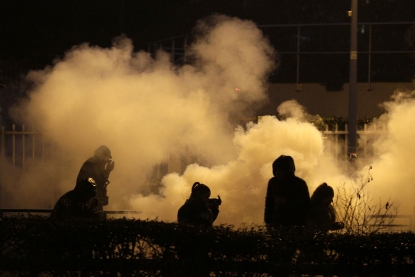 Bobigny, February 16, 2017. (AFP / Geoffroy Van Der Hasselt)
Bobigny, February 16, 2017. (AFP / Geoffroy Van Der Hasselt)The situation in Bobigny degenerated fairly quickly. The police fired tear gas, the protesters took off and what followed were hours of clashes and chases through the suburb’s housing projects.
In a situation like that, I rely on several things to figure out where I should go. There is the desk in Paris, which has its fingers on the pulse as it receives information from the various reporters on the ground and other news sources. I also often use Twitter or Periscope to find out where the action is.
That night, the protesters seemed to want to vent, to take revenge and clash with the police.
The police officers, on the other hand, seemed to have trouble keeping calm. When provoked, they often responded with cries of “Come closer, we’ll see how brave you are.”
I have a certain way of dressing when I know that things can get hot. I wear pants made from thick, tough material and always boots, never sneakers -- boots have tougher soles and that way I can avoid being injured by the various projectiles thrown by both sides. I put on a thick motorcycle vest -- it’s well padded so helps to protect me if I find myself in a scuffle. I always put it on under a jacket or a sweater -- if it shows, it can be taken as a provocation. Any protection that’s immediately visible can be taken as a provocation by demonstrators. When you see protection like that, you just get an urge to hit it -- like whenever you walk by a punching bag, you get an urge to hit it.
I try to wear a black sweater with a hood. The hood is useful when I’m shooting in the middle of the demonstrators, since many of them wear hoods, so I don’t stand out. I’m fairly tall -- 1m95 (6 foot 4 inches) -- so people tend to notice me right away and it’s helpful to minimize the attention by blending in.
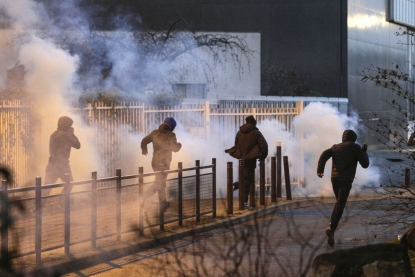 Bobigny, February 16, 2017. (AFP / Geoffroy Van Der Hasselt)
Bobigny, February 16, 2017. (AFP / Geoffroy Van Der Hasselt)You have to learn to maneuver between the two camps. When I’m close to the police, I make sure that my press badge is visible at all times. When I’m shooting among demonstrators, however, I hide it -- with its French flag and my photo, it slightly resembles a police id and the last thing that I need when I’m circulating between protesters spitting fire at police is to be taken for a cop.
Working near the demonstrators is fairly difficult. Since journalists aren’t on anyone’s “side,” they risk being roughed up and, more often than not, have their material stolen.
So for example, recently I wanted to go into a housing project near which there had been clashes with police. I ended up being pummelled with glass bottles, thrown -- judging by the voices that accompanied the assault -- by girls.
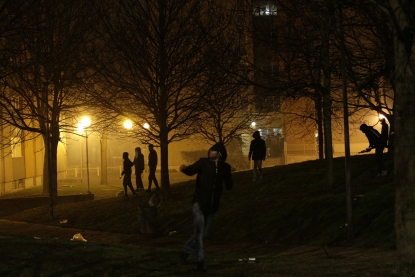 Bobigny, February 11, 2017. (AFP / Geoffroy Van Der Hasselt)
Bobigny, February 11, 2017. (AFP / Geoffroy Van Der Hasselt)Another time, I found myself in a cloud of tear gas. I didn’t feel well and was disoriented. I felt that one of my cameras had fallen from my shoulder. I turned around to pick it up. A guy had it in his hand. The camera strap had been cut. I managed to grab the camera from him.
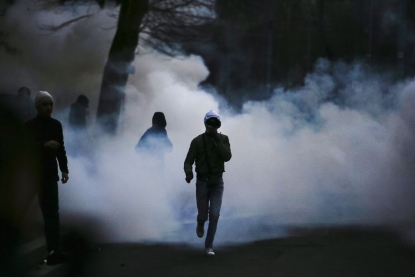 Bobigny, February 16, 2017.
(AFP / Geoffroy Van Der Hasselt)
Bobigny, February 16, 2017.
(AFP / Geoffroy Van Der Hasselt)Working on the police side is easier. It nearly always goes well. Usually the worse thing that you face there is that they don’t allow you to go somewhere.
Sometimes I follow them, like one time when I noticed a group on foot patrol inside a housing project. I just started following them, without saying anything. They noticed me right away, but didn’t say anything. If fact, they kind of took me under their wing. One of them kept looking behind, to make sure that I was still there and hadn’t fallen behind, alone, in a decidedly hostile housing project.
 Bobigny, February 16, 2017.
(AFP / Geoffroy Van Der Hasselt)
Bobigny, February 16, 2017.
(AFP / Geoffroy Van Der Hasselt)In situations like this, you have to be careful not to take unnecessary risks. To protect myself against tear gas, I have a neoprene anti-pollution mask that works fairly well. I also always have super strong glasses in my pocket. I carry a helmet in my backpack. I hesitate to wear it (like a body protection, it can be taken as a provocation by the demonstrators), but a helmet can be quite useful when objects start flying.
During the day I usually get around on my scooter. But at night, I prefer using a driver provided by the agency -- that way, it’s easier to store extra equipment in there and it makes for a safer get away, especially if things are being thrown at you.
 Bobigny, February 11, 2017. (AFP / Geoffroy Van Der Hasselt)
Bobigny, February 11, 2017. (AFP / Geoffroy Van Der Hasselt)I guess the main thing when covering demonstrations like these is to remain discreet, all the while blending in as much as possible.
This blog was written with Pierre Celerier and Yana Dlugy in Paris.
